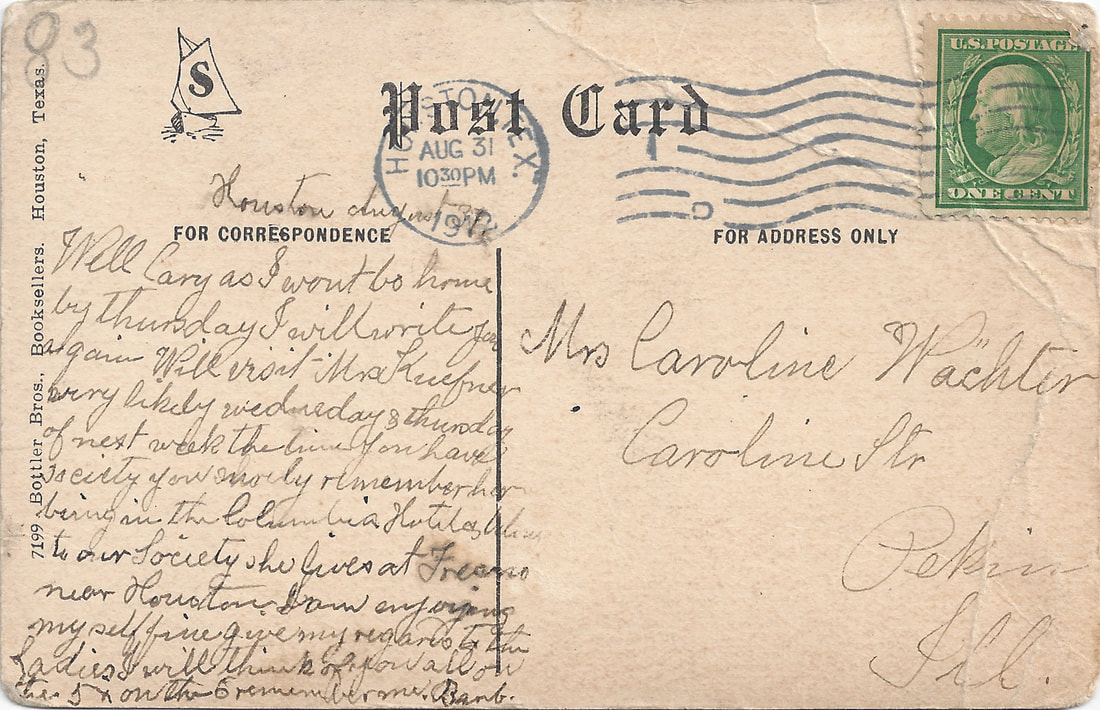Shearn Methodist
|
31 August 1912: Charles Shearn, a Texas Revolution patriot originally from England, founded what would become Shearn Methodist church in 1844, making it one of the oldest congregations in Houston. The church depicted in the 800 block of Texas between Milam and Travis was constructed in 1883, but by 1907 the district had become a bustling urban zone, and the congregation sold the church and moved to a quieter residential location on the southern edge of town on Main between Polk and Clay. [See the new church depicted at Main at Clay, as well as Main at Bell, and Front Street Entrance.
|
22 February 2014: The Chronicle Building that stood for so many decades on the site of the Shearn Methodist Church was the brainchild of Jesse Holman Jones, who came to Houston in 1898 and began acquiring real estate. He soon established a reputation as a shrewd businessman, and was one of the early investors in the Spindletop Oil strike in Beaumont. Another investor in Spindletop, Marcellus Foster, used his own profits to start a rival newspaper to the Houston Post which he called the Houston Chronicle. For a half interest in the paper, Jones agreed to build the Chronicle Building in the 800 block of Texas across from the Houston Post newspaper headquarters.
|
25 June 2018: Throughout most of 2017 the Chronicle Building was eroded away from the upper floors to the lower as the block was cleared of the historic structures [See Majestic Theater]. Plans are underway for the Hines Firm to build on the lot a new 47-story tower on the 800 block of Texas Avenue currently scheduled to open in late 2021. Tenants will include Vinson & Elkins, one of Houston’s oldest and largest law firms, as well as the global headquarters of Hines itself.
|
|
Postmarked: Aug 31, 1912 Houston, Tex.
Stamp: 1c Green Ben Franklin #374 To: Mrs Caroline Wachter Caroline Str. Pekin Ill. Message: Houston August 31 Well Cary as I want to [go] home by thursday I will write you again Will visit Mrs Kuefner very likely wedneday [sic] or thursday of next week the time you have society you shurely remember her being in the Columbia Hotel & [illegible] to our Society she lives at Fresno near Houston. I am enjoying myself fine give my regards to the Ladies I will think of you all on the 5th on the 6 remember me. Barb. |
Mrs. Caroline Wächter of Pekin, Tazewell County Illinois was the wife of Herman Wächter and daughter of John Elias Wehner and Katherina Seim, all of whom were immigrants from Germany. Caroline herself was born in Illinois in 1859 just a year after her parents arrived in America from Germany. There were a small number of women named Barb who might have been Cary’s friend. Of the 10 Barb’s on the city directory of Pekin in 1912, the woman's most affiliated with Cary was Barb Sheppert. Cary lived at 808 Caroline, while Barb Sheppert lived just 0.3 miles away at 1114 Caroline. On the census of 1900 the 2 families were are on the same page of the census a mere 5 households apart. Barb was also German in heritage, the daughter of John Deppert and Frances Seithen both immigrants from Germany. Barbara Deppert was very close to the same age, Barb was born June 1858 and Cary October 1859. Both were middle class, Nelson Sheppert was a cigar maker and Herman Wächter was a teamster and later a school janitor.
Barb’s family was close to the same size and composition as Cary’s. Caroline and Herman were the parents of Catherine (born 1882), Herman Ernest (1884), Emelia (1888), Lillian (1892), and Frederick (1893). The Sheppert children were: Nelson (1878), Frances (1883), John (1887), and Maria (1890). Herman died in 1940, and Cary in 1944; they are buried in Lakeside Cemetery in Pekin. Like Cary, Barb Sheppert was buried in Lakeside Cemetery, suggesting by association that they both were Protestants. These similarities in social history are compelling, but not entirely definitive. What is lacking is documentary evidence of their affiliation or a sample of Barb’s handwriting for comparison. Also not clear is the identity of Mrs Kuefner of Fresno, Fort Bend County, TX mentioned in the text. Fresno in 1914 was a tiny place with only 32 inhabitants, but the census does not reveal a Mrs. Kuefner among the citizens. |

